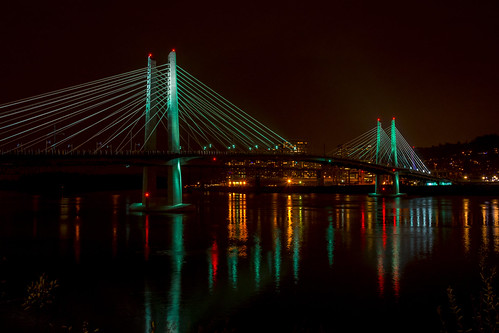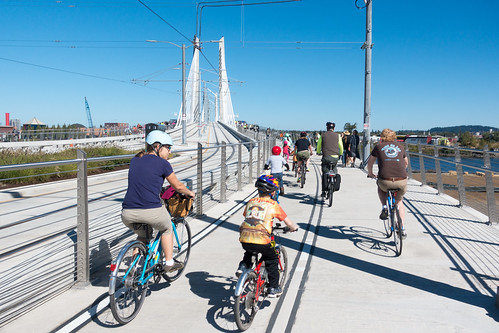Tilikum Crossing Bridge as a model for the DC-Virginia Long Bridge Expansion Project
I have been remiss in submitting comments to the Long Bridge Project, where I intended to suggest that the bridge, mostly conceptualized as a railroad expansion project going from two to four tracks to better serve railroad passenger service, should also have a dedicated busway, to provide an exclusive routing for buses crossing the Potomac River as well as providing redundancy and another connection to DC from National Airport.
A Public Information Meeting was held on December 14, 2017 to present the proposed alternatives to be evaluated in the Draft EIS. The meeting materials can be viewed here. Comments can be submitted until Tuesday January 16th, 2018, to info@longbridgeproject.comThe bridge is owned by CSX Transportation, a freight railroad, and is adjacent to a separate bridge for Metrorail.
CSX prioritizes freight transportation, and passenger rail use is secondary. Expansion to accommodate passenger rail will have to be borne by the public. Virginia's desires to expand railroad service south and to expand VRE passenger service are held hostage to the two tracks.
For example, because there aren't enough "slots" available during peak service hours, for the most part, VRE trains make only one trip each way in the morning and night, so that they are forced to buy and operate more equipment than if trains could make round trips. This also stresses storage capacity within DC.
As part of Virginia's Atlantic Gateway project, they have prioritized the expansion of the Long Bridge, and in an MOU with DC, are taking the lead in making the expansion happen.
Today, the Washington Area Bicyclist Association sent out an advocacy email ("A better bike bridge over the Potomac and two highways"), making the point that the Long Bridge expansion should or could include an exclusive bikeway, but this is not a priority in the recommendations. From WABA:
- Make the Long Bridge bicycle and pedestrian connection continue across the George Washington Parkway to connect to the Long Bridge Park (Arlington County’s Long Bridge Park Master Plan has long called for a connection from the park’s multi-use esplanade across the George Washington Parkway to the Mount Vernon Trail)
- Make the Long Bridge bicycle and pedestrian connection connect directly to Maine Avenue, instead of requiring an indirect, congested or outdated connection across the Washington Channel
- Leave space for a future trail connection across Maine Ave to Maryland Ave and Hancock Park, and
- Build the bicycle and pedestrian infrastructure simultaneously with the rail span, not as a separate project.
The Tilikum Crossing Bridge supports the local light rail, the Orange Line MAX, streetcar, buses, pedestrians and bicyclists, and emergency vehicles. It also has been designed to incorporate special architectural lighting.

This photo shows a light rail train, a streetcar and buses using the bridge at the same time.


Bicyclists using the bikeway section of the Tilikum Crossing Bridge.
Why not reconceptualize the Long Bridge project similarly? and include elements that support bus transit and biking and walking.
To highlight the city's focus on sustainable mobility, DC needs an exclusively sustainable mobility bridge, which is in keeping with the priorities of the MoveDC transportation master plan and the Sustainability Plan, which aims to achieve 75% of work trips by sustainable means.
The expansion of the bridge for passenger rail also enables my recommendation to merge the MARC Penn Line and the VRE Fredericksburg Line as a step towards creating a regional railroad passenger service I call RACER ("A new backbone for the regional transit system: merging the MARC Penn and VRE Fredericksburg Lines").
Labels: bicycle and pedestrian planning, bridges, bus transit, infrastructure, sustainable mobility, sustainable mobility platform, transportation planning


5 Comments:
There's little reason to include bus in the Long Bridge. That was actually considered earlier and rejected.
The reason is, unlike the Tilikum Crossing, there is already a road bridge (complete with HOV restrictions/benefits for buses) in the same area. Adding bus to this project is not needed, nor beneficial.
The bike/ped portion should be strengthened, because it's a) relatively cheap, and b) offers more benefit.
my point was more about redundancy and emergency management planning.
In the post 9/11 world, planning for the possibility that something could happen to the 14th St. bridge and take it out of service for awhile is something that needs to be considered, more broadly.
given that there are only 9 crossings in this area: Wilson Bridge; 14th St.; Long Bridge and Metro Yellow Line; Memorial Bridge; Roosevelt Bridge; Metro Tunnel; Key Bridge; Chain Bridge, and then the Memorial Bridge in Maryland.
Why not add a bus transit/emergency vehicles crossing?
But from the standpoint of "efficiency" without taking that into consideration, a bus crossing wouldn't be seen as a priority.
cf. https://books.google.com/books?id=tw9h1hCQmG4C&pg=PA44&source=gbs_toc_r&cad=4#v=onepage&q&f=false
Why not? Because it’s a massive increase in scope for little benefit.
Light Rail and streetcars are designed to operate in mixed traffic. Their operators are trained to do it. Hence, there’s nothing odd about buses and trains not just sharing a bridge, but sharing the same lanes in Portland.
That is absolutely not the case for the Long Bridge, which is mainline rail. We spend lots of money to eliminate grade crossings for mainline rail, both for freight and passengers. So, you can’t have buses and trains sharing a lane. Which means adding buses just means making a much wider bridge, which means a greatly more expensive bridge. Plus, there are no roads that connect to the existing Long Bridge, since it’s a rail bridge, you’d have to build tons of ramps and connectors at great cost and for little benefit.
Agree cost/benefit. I'd rather someday see a better 14th st bridge that consolidates the badly designed winding tangle of bridges and ramps on both sides.
OK, ok, you convinced me.
WRT to anon's comment:
Agree cost/benefit. I'd rather someday see a better 14th st bridge that consolidates the badly designed winding tangle of bridges and ramps on both sides.
At some point in the future a changed configuration for the 14th St. bridge makes more sense.
But there is still that issue of redundancy.
Post a Comment
<< Home